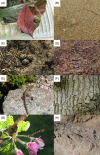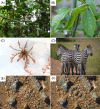The key role of behaviour in animal camouflage
- PMID: 29927061
- PMCID: PMC6378595
- DOI: 10.1111/brv.12438
The key role of behaviour in animal camouflage
Abstract
Animal camouflage represents one of the most important ways of preventing (or facilitating) predation. It attracted the attention of the earliest evolutionary biologists, and today remains a focus of investigation in areas ranging from evolutionary ecology, animal decision-making, optimal strategies, visual psychology, computer science, to materials science. Most work focuses on the role of animal morphology per se, and its interactions with the background in affecting detection and recognition. However, the behaviour of organisms is likely to be crucial in affecting camouflage too, through background choice, body orientation and positioning; and strategies of camouflage that require movement. A wealth of potential mechanisms may affect such behaviours, from imprinting and self-assessment to genetics, and operate at several levels (species, morph, and individual). Over many years there have been numerous studies investigating the role of behaviour in camouflage, but to date, no effort to synthesise these studies and ideas into a coherent framework. Here, we review key work on behaviour and camouflage, highlight the mechanisms involved and implications of behaviour, discuss the importance of this in a changing world, and offer suggestions for addressing the many important gaps in our understanding of this subject.
Keywords: behaviour; camouflage; crypsis; decision-making; learning; movement; vision.
© 2018 The Authors. Biological Reviews published by John Wiley & Sons Ltd on behalf of Cambridge Philosophical Society.
Figures


References
-
- Allen, J. J. , Mäthger, L. M. , Barbosa, A. , Buresch, K. C. , Sogin, E. , Schwartz, J. , Chubb, C. & Hanlon, R. T. (2010). Cuttlefish dynamic camouflage: responses to substrate choice and integration of multiple visual cues. Proceedings of the Royal Society of London B: Biological Sciences 277, 1031–1039. - PMC - PubMed
-
- Allen, W. L. , Baddeley, R. , Scott‐Samuel, N. E. & Cuthill, I. C. (2013). The evolution and function of pattern diversity in snakes. Behavioral Ecology 24, 1237–1250.
-
- Amat, J. A. , Monsa, R. & Masero, J. A. (2012). Dual function of egg‐covering in the Kentish plover Charadrius alexandrinus . Behaviour 149, 881–895.
-
- Bailey, I. E. , Muth, F. , Morgan, K. , Meddle, S. L. & Healy, S. D. (2014). Birds build camouflaged nests. The Auk 132, 11–15.
-
- Baños‐Villalba, A. , Quevedo, D. P. & Edelaar, P. (2018). Positioning behavior according to individual color variation improves camouflage in novel habitats. Behavioral Ecology 29, 404–410. 10.1093/beheco/arx181. - DOI
Grants and funding
LinkOut - more resources
Full Text Sources
Other Literature Sources

